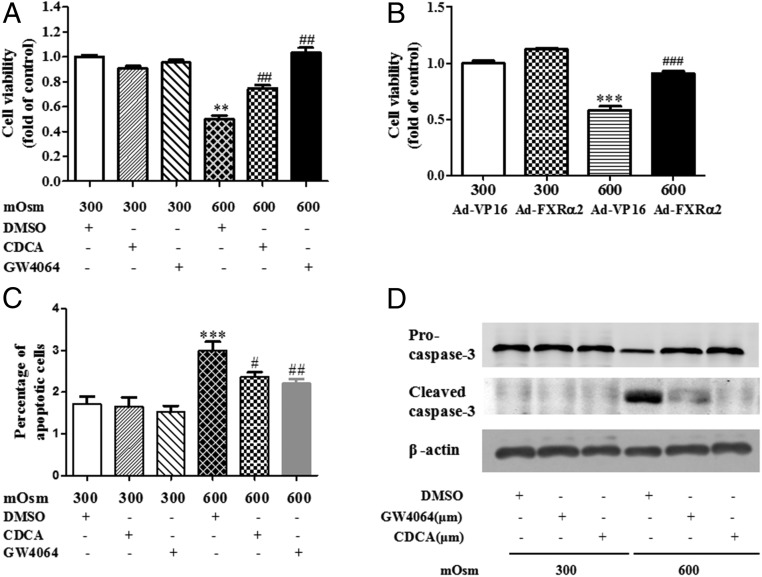Fig. 3.
FXR protected mIMCD3 cells from hypertonic stress-induced cell apoptosis. The mIMCD3 cells were subjected to hypertonicity (600 mOsm) for 6 h in the presence or absence of FXR selective agonist GW4064 and CDCA. (A) MTT cell viability analysis showing that hypertonicity-induced cell death was significantly attenuated by GW4064 and CDCA treatment. **P < 0.01 vs. 300 mOsm+DMSO, ##P < 0.01 vs. 600 mOsm+DMSO (n = 10). (B) Overexpression of FXR-ameliorated mIMCD3 cell death under hypertonic stress. Cells were infected with Ad-FXRα2 or Ad-VP16. After 36 h of infection, the cells were challenged with hypertonic stress (600 mOsm) for 6 h. Cell viability was determined by the MTT assay. ***P < 0.001 vs. 300 mOsm+Ad-VP16, ###P < 0.001 vs. 600 mOsm+Ad-VP16 (n = 6). (C) FXR activation blocked hypertonicity-induced apoptosis of mIMCD3 cells. The mIMCD3 were treated with isotonic (300 mOsm) or hypertonic medium (600 mOsm) for 6 h, and apoptotic cells were analyzed by the flow cytometry. Treatment of cells with GW4064 (2.5 μM) and CDCA (50 μM) markedly reduced hypertonicity-induced cell apoptosis. ***P < 0.001 vs. 300 mOsm+DMSO, and #P < 0.05 and ##P < 0.01 vs. 600 mOsm+DMSO (n = 3). (D) FXR activation with GW4064 and CDCA markedly reduced hypertonicity-induced activation of the caspase-3 apoptotic cascade. Note that protein expression of the apoptotic marker, cleaved caspase-3, was markedly attenuated by GW4064 and CDCA. The results are representative of three independent experiments.

